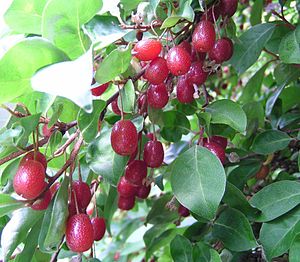Rich flowering olive willow
| Rich flowering olive willow | ||||||||||||
|---|---|---|---|---|---|---|---|---|---|---|---|---|

Rich flowering olive willow ( Elaeagnus multiflora ) |
||||||||||||
| Systematics | ||||||||||||
|
||||||||||||
| Scientific name | ||||||||||||
| Elaeagnus multiflora | ||||||||||||
| Thunb. |
The Elaeagnus multiflora ( Elaeagnus multiflora Thunb.), Also edible oil pasture , Red Summer Ölweide , Long-stemmed Ölweide , Japanese Ölweide called, is a species of the genus of Oleaster ( Elaeagnus ) within the family of elaeagnaceae (Elaeagnaceae).
distribution
The plant species is common in Northeast Asia from China, Korea and Japan. In Germany you can find them in parks, gardens and at the roadside in near-natural hedges.
description
The rich flowering olive willow is a frost hardy and robust, deciduous, unreinforced, 2–8 m high shrub. The slightly rough to finely scaly bark is gray-brown.
The short-stalked, pale green underneath leaves are ovate to elliptical or lanceolate to obovate. The leaves are up to 10 centimeters long, with a petiole about 0.5 centimeters long. They have entire margins and at the top they are rounded or rounded to a point. The petiole is usually white to silvery or brownish scales. The young leaves are covered on the underside with many white to silvery and some brownish scales (pupils), which then become fewer. On the upper side they are white and dotted, with star-haired hair and then slowly shed. The nerve is pinnate, with finely developed lateral veins.
The hermaphroditic flowers with a simple flower cover appear axillary, individually or in small groups, usually in pairs. The stalked, mostly pendulous flowers are white and more or less white to silvery or brownish scales. The petals are missing and the flower cup is elongated, tubular. The four white, petaloid sepals are bell-shaped and constricted at the base, with shorter, triangular tips. The stamens in the calyx are short. The ovary is medium constantly with a pen with elongated, fleshy tongue-shaped scar .
The white, yellowish, sweet-smelling flowers appear in May / June. The dark red-brown to orange-red, more or less white-dotted-scaly, egg-shaped to ellipsoidal, about 1.2-1.4 centimeters large drupes are edible, juicy, sweet and sour, they ripen in August / September. The orange-light brownish, narrow-ellisoid seeds are ribbed and 8-10 millimeters long.
ecology
Similar to legumes (legumes) and other oleaginous plants, the rich-flowered oleaginous is able, with the help of bacteria living in symbiosis ( Frankia ), to bind atmospheric nitrogen in nodule-like structures at the roots, convert it and make it available to the plants. Analogous to the mycorrhiza, this form of symbiosis is called actinorrhiza . The plant therefore also thrives on nutrient-poor soils, is resistant to heat, drought and wind, and is therefore suitable as a pioneering wood for fastening embankments and dunes. It is a good pasture for bees when in bloom.
use
The rich flowering olive willow is used as an ornamental wood with fruit decorations. It is also a useful wood because of its ability to grow in nutrient-poor soil. The juicy, sweet and sour stone fruits can be made into jam, jelly or compote, mixed with other fruits. Only ripe fruits are tasty to eat fresh. The fruits can also be fermented into alcoholic beverages.
Others
The rich flowering olive willow can sometimes be confused with the very similar coral olive willow ( Elaeagnus umbellata ), which also comes from Northeast Asia. The variety 'Sweet Scarlet' with large fruits comes from the Ukraine and was selected in Kew Gardens (London). Other varieties of 'Red Cherry' with fragrant flowers and tasty red fruits. The variety 'Variegata' with marbled, light yellow patterned leaves.
swell
- Elaeagnus multiflora in the Flora of China, Vol. 13.
- Andreas Bärtels: Encyclopedia of the garden trees. Ulmer, Stuttgart 2001, p. 261.
- Bundessortenamt: Descriptive List of Varieties 1999 , ISSN 1430-9378 , pp. 54–58.
- Jeanne Dericks-Tan, Gabriele Vollbrecht: On the trail of wild fruits in Europe. Abadi Verlag, Alzenau 2009, ISBN 978-3-00-021129-4 , p. 201.
Web links
- Thomas Meyer: Data sheet with identification key and photos at Flora-de: Flora von Deutschland (old name of the website: Flowers in Swabia )
Individual evidence
- ↑ Elaeagnus multiflora from Flora Italiana, Schede di Botanico, accessed on September 4, 2019.
